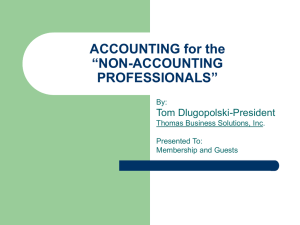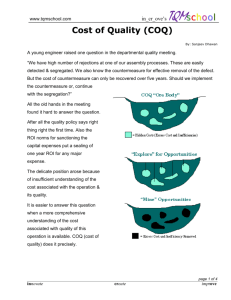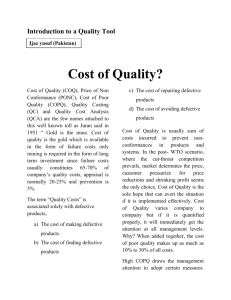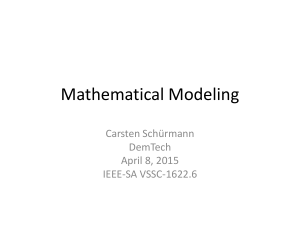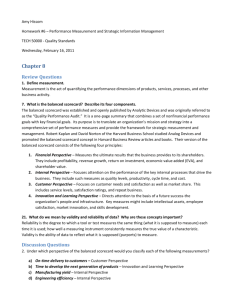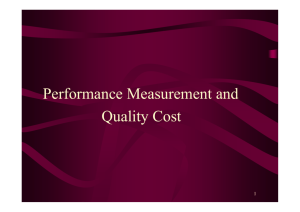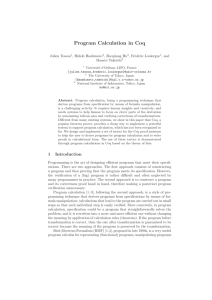Cost of Quality as a Driver for Continuous Improvement
advertisement
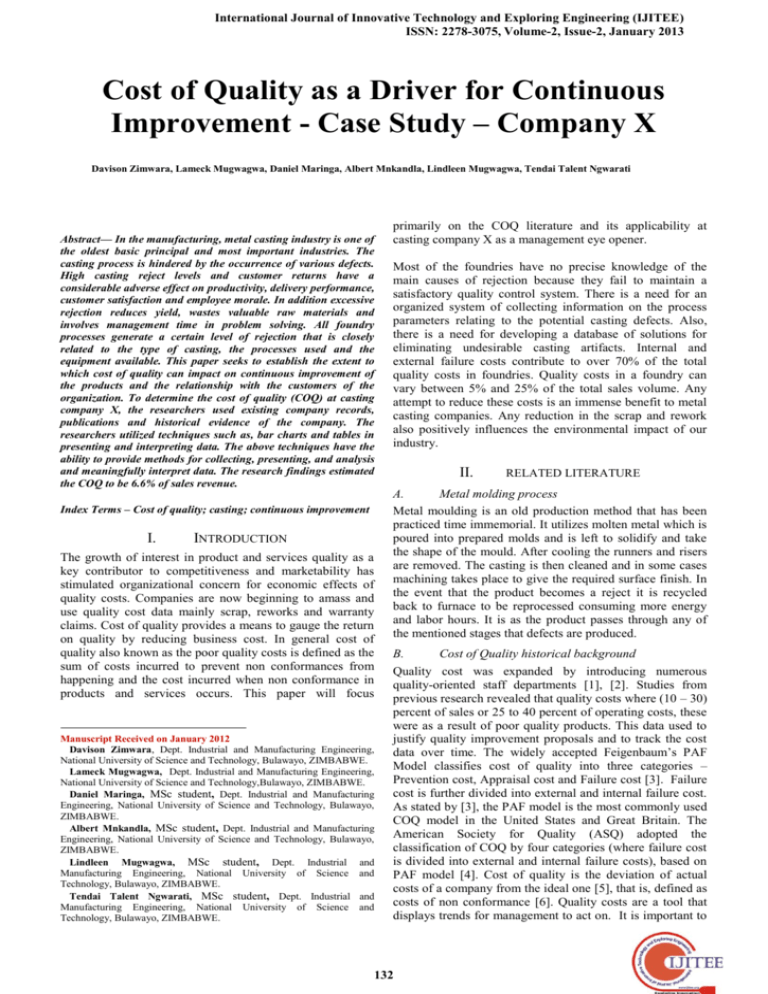
International Journal of Innovative Technology and Exploring Engineering (IJITEE) ISSN: 2278-3075, Volume-2, Issue-2, January 2013 Cost of Quality as a Driver for Continuous Improvement - Case Study – Company X Davison Zimwara, Lameck Mugwagwa, Daniel Maringa, Albert Mnkandla, Lindleen Mugwagwa, Tendai Talent Ngwarati Abstract— In the manufacturing, metal casting industry is one of the oldest basic principal and most important industries. The casting process is hindered by the occurrence of various defects. High casting reject levels and customer returns have a considerable adverse effect on productivity, delivery performance, customer satisfaction and employee morale. In addition excessive rejection reduces yield, wastes valuable raw materials and involves management time in problem solving. All foundry processes generate a certain level of rejection that is closely related to the type of casting, the processes used and the equipment available. This paper seeks to establish the extent to which cost of quality can impact on continuous improvement of the products and the relationship with the customers of the organization. To determine the cost of quality (COQ) at casting company X, the researchers used existing company records, publications and historical evidence of the company. The researchers utilized techniques such as, bar charts and tables in presenting and interpreting data. The above techniques have the ability to provide methods for collecting, presenting, and analysis and meaningfully interpret data. The research findings estimated the COQ to be 6.6% of sales revenue. Index Terms – Cost of quality; casting; continuous improvement I. INTRODUCTION The growth of interest in product and services quality as a key contributor to competitiveness and marketability has stimulated organizational concern for economic effects of quality costs. Companies are now beginning to amass and use quality cost data mainly scrap, reworks and warranty claims. Cost of quality provides a means to gauge the return on quality by reducing business cost. In general cost of quality also known as the poor quality costs is defined as the sum of costs incurred to prevent non conformances from happening and the cost incurred when non conformance in products and services occurs. This paper will focus Manuscript Received on January 2012 Davison Zimwara, Dept. Industrial and Manufacturing Engineering, National University of Science and Technology, Bulawayo, ZIMBABWE. Lameck Mugwagwa, Dept. Industrial and Manufacturing Engineering, National University of Science and Technology,Bulawayo, ZIMBABWE. Daniel Maringa, MSc student, Dept. Industrial and Manufacturing Engineering, National University of Science and Technology, Bulawayo, ZIMBABWE. Albert Mnkandla, MSc student, Dept. Industrial and Manufacturing Engineering, National University of Science and Technology, Bulawayo, ZIMBABWE. Lindleen Mugwagwa, MSc student, Dept. Industrial and Manufacturing Engineering, National University of Science and Technology, Bulawayo, ZIMBABWE. Tendai Talent Ngwarati, MSc student, Dept. Industrial and Manufacturing Engineering, National University of Science and Technology, Bulawayo, ZIMBABWE. primarily on the COQ literature and its applicability at casting company X as a management eye opener. Most of the foundries have no precise knowledge of the main causes of rejection because they fail to maintain a satisfactory quality control system. There is a need for an organized system of collecting information on the process parameters relating to the potential casting defects. Also, there is a need for developing a database of solutions for eliminating undesirable casting artifacts. Internal and external failure costs contribute to over 70% of the total quality costs in foundries. Quality costs in a foundry can vary between 5% and 25% of the total sales volume. Any attempt to reduce these costs is an immense benefit to metal casting companies. Any reduction in the scrap and rework also positively influences the environmental impact of our industry. II. RELATED LITERATURE A. Metal molding process Metal moulding is an old production method that has been practiced time immemorial. It utilizes molten metal which is poured into prepared molds and is left to solidify and take the shape of the mould. After cooling the runners and risers are removed. The casting is then cleaned and in some cases machining takes place to give the required surface finish. In the event that the product becomes a reject it is recycled back to furnace to be reprocessed consuming more energy and labor hours. It is as the product passes through any of the mentioned stages that defects are produced. B. Cost of Quality historical background Quality cost was expanded by introducing numerous quality-oriented staff departments [1], [2]. Studies from previous research revealed that quality costs where (10 – 30) percent of sales or 25 to 40 percent of operating costs, these were as a result of poor quality products. This data used to justify quality improvement proposals and to track the cost data over time. The widely accepted Feigenbaum’s PAF Model classifies cost of quality into three categories – Prevention cost, Appraisal cost and Failure cost [3]. Failure cost is further divided into external and internal failure cost. As stated by [3], the PAF model is the most commonly used COQ model in the United States and Great Britain. The American Society for Quality (ASQ) adopted the classification of COQ by four categories (where failure cost is divided into external and internal failure costs), based on PAF model [4]. Cost of quality is the deviation of actual costs of a company from the ideal one [5], that is, defined as costs of non conformance [6]. Quality costs are a tool that displays trends for management to act on. It is important to 132 Cost of Quality as a Driver for Continuous Improvement - Case Study – Company X carry out quality cost analysis in an organization and this information can be used by management to identify quality costs, prioritize quality cost reduction activities and measure the success of such activities. Figure 2: Quality costs categories Figure 1: Casting process flow chart adapted from company X There are many ways that have been proposed by various researchers on how to measure Cost of Quality. Through the years the COQ models have been developed and many authors agree on the following classes of COQ models; P-A-F model Crosby’s model Opportunity cost models Process cost models ABC models C. Components of Cost of Quality Prevention costs: These are costs incurred by an organization when they try to investigate, prevent or reduce the risks of non conformity. These costs are planned and are associated with the design, implementation and maintenance of a total quality management system. Appraisal costs: These are costs associated with evaluation and verification of purchased goods, services, and processes by an organization to ensure that they are within specified requirements. Examples of these costs include production trial test costs, test and measurement costs. Step 1 Project initialization and preparation Step 2 Assessment of current business performance Step 3 Project organization and assignments Step 4 Identification of major costs of conformance and costs of non conformance items Step 5 needs Step 6 Collect ,compile and process cost of quality data Step 7 Analyze cost of quality to identify opportunities for improvements Step 8 Step 9 Establish continuous improvement of the cost of quality performance Step Conduct quality audits regularly and initiate 10 document changes in response to improvements made in various processes E. General benefits of implementing COQ [7] External failure costs: These are costs an organization incurs after delivering to the customer non conforming products Examples of these costs includes equipment failure, downtime and warranty. I - Steps in implementing COQ Activities [7] Organize and implement quality improvement and cost reduction programs Internal failure costs: These are costs that arise from failure of products to conform to customer requirements. These can be categorized into costs of scrap, rework, retest, re-inspection, modification, downtime, overtime, corrective action and redesign costs. D. Stages in the cost of quality implementation The steps to the implementation of COQ are shown in table1 Identification and provision of additional training Can be used to quantify qualitative improvements Can be used to determine problem areas and action priorities Can be used for investment appraisal purposes and to asses overall effectiveness of the quality programmes COQ reporting has the potential of bringing numerous benefits to the organizations but the organizations must also 133 International Journal of Innovative Technology and Exploring Engineering (IJITEE) ISSN: 2278-3075, Volume-2, Issue-2, January 2013 be aware of difficulties encountered during the implementation period so that they are better prepared to overcome the obstacles. The major purpose of a cost of quality system is to reduce costs through identifying improvement opportunities[8]. According to [8], quality costs programmes fail because: Some organisations use the COQ information as a scorekeeping tool rather than as a driver for continual improvement Preoccupation with perfection in determining the COQ figures Underestimation of the depth and extend of commitment required to be made to prevention F. Cost of Quality metrics COQ measurement systems have a mixture of global and detailed metrics [9]. Some examples of detailed metrics are given in Table II. Global quality metrics measure global performance; some examples are also given in Table II. II. Cost of Quality metrics [9] Detailed metrics Global metrics Cost of assets Return on quality Cost of labour Quality rate Cost of defects per Process quality 100 pieces Cost of quality Cost of late deliveries Time between service calls Number of complaints received III. METHODOLOGY Primary data was collected by direct observation during plant operation visits and during working hours; and through personal interviews with managers, superintendents, supervisors and general workers. The gathered information was used to quantify the quality cost in tabular format. Secondary data from existing records, publication and historical evidence of the company from the company library and recordings was collected. The researchers utilized techniques such as bar charts and tables in presenting and interpreting data. The above techniques have the ability to provide methods for collecting, presenting and analysis and meaningfully interpret data. The following steps were used in identifying the costs of quality at company X: Phase 1: Identification of non conformance costs These were categorized into internal and external failure. Table III shows what was considered in this section III: Failure Cost Internal failure External failure Rework Scrap Downtime Obsolescence Defect/failure analysis Re-inspection / retesting Downgrading Complaints Warranty claim Phase 2: Quantification of Cost of Quality Records from Production, Operation, Accounting records were used in the gathering of information of quality costs at the company. IV. RESULTS Results of the research are presented in the next section A. Problems Identified The problems can be classified into the following categories: Core making; Poor surface finish and Completely damaged core Moulding; Misalignment of cope and drag box Melting and pouring; Short pouring, Slag and sand inclusion The process was analysed by considering each step in the casting process. This was done to identify all the wastes in the shop floor. This helped to determine value adding and non value adding activities carried out in the casting process at the case study company. The non value adding activities are removed so as to reduce time wasting and also to meet customer demand on time. There are also some processes essential in the casting process which do not value to the final product but have to be carried out and these are called required non value added activities. B. Prevention costs Table IV summarises the results of prevention cost. Fig. 3 summarises the preventive cost for the period under review. As can be seen preventive costs are low indicating the system at company X is not proactive. C. Appraisal Activities The findings of appraisal costs are summarized in Table V. These findings are also illustrated in graphical format in Fig. 4. As can be seen appraisal costs are not significant which illustrates again the system has a feedback system that is not effective, resulting in poor preventive methods to avert failure. D. Internal Failure Costs The major cost elements are as detailed in Table VI.Fig. 5 gives the summary of internal failure costs. As can be seen internal failure costs are huge indicating that the system at company X is not yet mature. Measures need to be put in place to minimize the failure rate hence the COQ. E. External Failure Costs Table VII and Fig. 6 illustrate the quantum of external failures. This shows that the system at the case study company needs a proactive approach so that external failures are brought to a minimum. 134 Cost of Quality as a Driver for Continuous Improvement - Case Study – Company X IV: Preventive Costs Element Description A1a A1b Quality engineering (Translating product design or customer quality requirements into manufacturing quality controls of materials and process) Process Engineering (Cost of implementing and maintaining quality plans and procedures) A2 Design and development of quality measurement and control equipment A3 Quality planning by functions other than Quality control department A4 Calibration and maintenance of production equipment used to evaluate quality A5 Maintenance and Calibration of test and inspection equipment A6 Supplier Assurance A7 Quality training A8 Administration, Audit, and improvement Fig 3: Preventive Costs 135 International Journal of Innovative Technology and Exploring Engineering (IJITEE) ISSN: 2278-3075, Volume-2, Issue-2, January 2013 V: Appraisal Cost Element Description B1 Laboratory acceptance testing (purchased production materials) B2 Inspection and testing (quality control department) B3 In process inspection (Non quality control personnel) B4 Setup for testing and inspection B5 Inspection and test materials (Materials consumed or destroyed in the control of quality) B6 Product Quality audits B7 Review of test and inspection data B8 Field Performance testing (on site visits) B9 Internal testing and release B10 Evaluation of Site material B11 Data processing inspection and test reports Fig 4: Appraisal Costs VI: Internal Failure Cost Element Description C1 Scrap costs: Labour, consumables and other costs that cannot be recovered. C2 Re-work and Repair: Gears and steel casting. C3 Trouble shooting (defect failure analysis) to determine cause: Done by Production / Laboratory C4 Re-inspection and retesting of reworks: Conducted by the production senior personnel C5 Scrap and Reworks: Fault of supplier, downtime C6 Modifications, permits and concessions: Redesign of running systems and modifications C7 Downgrading: Downgrading of grinding media 136 Cost of Quality as a Driver for Continuous Improvement - Case Study – Company X Fig. 5: Internal quality costs VII: External Failure Costs Element Description D1 Complaints administration D2 Product liability D3 Handling and accounting costs of products rejected or recalled D4 Returned Material repairs D5 Warranty replacement Figure 6: External failure cost VIII: Summary of COQ by categories Cost category as collected % of COQ % of Turnover Prevention 14,500.00 9% 0.6% Appraisal 14,382.00 9% 0.6% Internal Failure 105,179.98 63% 4.2% External Failure 32,293.11 19% 1.3% 100% 6.6% TOTAL 166,355.09 F. Summary of COQ costs Table VIII summarizes the observed costs by category. From the table, 63% of COQ is attributed to internal failure and 4.2% of sales revenue. From the table the COQ is estimated to be 6.6% of sales revenue, which is in the range 5% to 25% [10]. As can be seen from the graph the three elements C2, C1 and D5 constitute the bulk of the COQ. G. COQ cost elements Table IX and Fig. 7 show the major three cost drivers of COQ namely scrap rework and warranty costs. 137 International Journal of Innovative Technology and Exploring Engineering (IJITEE) ISSN: 2278-3075, Volume-2, Issue-2, January 2013 Figure 7: COQ Cost elements IX – COQ drivers COST ELEMENT COST ( US$) % OF TURNOVER Scrap (C1) 31,360.81 1% Rework (C2) 56,499.27 2% Warranty cost (D5) 20,296.11 1% 108,156.19 4% TOTAL the expectation of the customer relating to the product. V. RECOMMENDATIONS For the company to continuously satisfy customers it is important to keep up to date information on customer’s complaints for it to be easy to make continuous improvements in the quality of products. Quality responsibility must be clearly defined to all employees. Employees must be involved in quality planning to help reduce the number of defects in the department. There must be a quality plan for suppliers to safeguard the quality of incoming raw materials. All employees must be trained in quality concepts. There is need to first map customer’s specifications into technical specification and listening to the voice of customers before production starts. The company may implement ISO9001- 2008 as part of its Total Quality Management (TQM) system to benefit from reduced P-A-F since continuous improvement is at the heart of (TQM). The concept of value engineering must be understood so as to realise what the product is and VI. CONCLUSION The application of the cost of quality approach in the foundry industry environment provides a systematic, structured approach to the quality problem and identification of correction that focuses on unfavourable variances in operational performances. The approach presented and applied in this study, capitalizes on the system orientation of business organization, continuous quality improvement techniques, proactive managerial actions, to achieve product efficiency, customer satisfaction, and strategic effectiveness. There are many undiscovered opportunities to convert quality and process improvements into bottom-line benefits. However, the details of the assessment of missed quality objectives and means for quantifying and implementing corrective actions were previously missing. The research presented here provides a significant step toward overcoming these difficulties by providing a systematic practical approach to addressing the cost of quality. For an organization to realize the operational, strategic and customer-related benefits of the approach proposed here, it must meet the following requirements and undertake the required changes: (a) Organisational structure-related requirements and changes, (b) Technical requirements and changes, and (c) Informational requirements and changes. 138 Cost of Quality as a Driver for Continuous Improvement - Case Study – Company X REFERENCES [1] J. Juran, Quality Control Handbook, 1st ed., McGraw-Hill, New York, NY, 1951 [2] S. Rodchua,Factors, Measures, and Problem of Quality Costs Program Implementation in the Manufacturing Environment, Journal of Industrial Technology, Volume 22, number 4, October 2006 through to December 2006. [3] M. Rasamanie,and K. Kanapathy,The Implementation of Cost of Quality (COQ) Reporting System in Malaysian Manufacturing Companies. Difficulties Encountered and Benefits Acquired. International Journal of Business and Social Science Volume 2, Number 6, April 2011 [4] V. Sower, M. Savoie and S. Renick,An Introduction to Quality Management and Engineering, Prentice-Hall, Upper Saddle River, NJ.1999 [5] J. Campanellaand F. Corcon, Principles of Quality Costs, 2nd ed., ASQ Quality Press, Milwaukee,1990 [6] P. Crosby, Quality is Free, McGraw-Hill, New York, NY, 1983 [7] J.T.S San,Applying Cost of Quality to Total Quality Management, Pakistan Institute of Quality Control – ( ICQI'2000) [8] D. Montgomery, Introduction to Statistical Quality Control, Wiley, New York, NY.(1996), [9] N.M. Vaxevanidis andG. Petropoulos, A Literature Survey of Cost of Quality Models, Annals of the Faculty of Engineering Hunedoara – Journal of Engineering. Tome VI (year 2008). Fascicule 3 (ISSN 1584 – 2673), 2008, pp 274 – 283 [10] J. Plunkett and B. Dale, “Quality costing: First Edition, Chapman and Hall, New York, NY, 1991 Tendai Talent Ngwarati, MSc student, Dept. Industrial and Manufacturing Engineering, National University of Science and Technology, Bulawayo, ZIMBABWE tngwarati@gmail.com Albert Mnkandla, MSc student, Dept. Industrial and Manufacturing Engineering, National University of Science and Technology, Bulawayo, ZIMBABWE ankhabo@gmail.com. Lindleen Davison Zimwara, PhD Candidate, Lecturer Department of Industrial and Manufacturing Engineering, National University of Science and Technology(NUST);Research fields, Environmental Conscious Manufacturing, Quality systems, Renewable energy, World Class Manufacturing Strategies, Emails davison.zimwara@nust.ac.zw, davison.zimwara@gmail.com Cell-+263772900922 Mugwagwa, MSc student, Manufacturing Engineering, National Technology, Bulawayo, ZIMBABWE lindimutseiwa@gmail.com Daniel Maringa, MSc student, Dept. Industrial and Manufacturing Engineering, National University of Science and Technology, Bulawayo, ZIMBABWE danymaringa@gmail.com Lameck Mugwagwa, Full-time Lecturer, NUST who holds MEng in Manufacturing Engineering and Operations Management (NUST) and BTech (Hons) in Production Engineering (CUT), Zimbabwe. Research interests are in Manufacturing Processes Optimization and Material Science using Artificial Intelligence, Neural Networks. mgwagwal@gmail.com 139 Dept. Industrial University of Science and and
